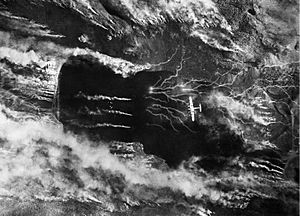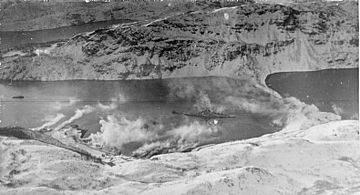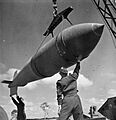Operation Paravane facts for kids
Quick facts for kids Operation Paravane |
|||||||
|---|---|---|---|---|---|---|---|
| Part of World War II | |||||||
 A British Lancaster bomber over Kaafjord during Operation Paravane |
|||||||
|
|||||||
| Belligerents | |||||||
| Commanders and leaders | |||||||
| Casualties and losses | |||||||
| 11 killed 6 or 7 heavy bombers destroyed in accidents |
1 battleship heavily damaged 5 killed, 15 wounded |
||||||
Operation Paravane was a special British air attack during World War II. Its goal was to seriously damage the German battleship Tirpitz. This huge warship was hiding in Kaafjord, a fjord in northern Norway.
The attack happened on September 15, 1944. Twenty-one Royal Air Force (RAF) heavy bombers flew all the way from an airfield in the Soviet Union. One bomb hit the Tirpitz, and several others landed very close by. This damage made Tirpitz unable to fight. It couldn't be fixed because the Germans couldn't move it to a big port for repairs.
Before this, the Royal Navy had tried many times to sink Tirpitz using planes from aircraft carriers. These attacks happened between April and August 1944. The first one, Operation Tungsten, worked well, but later attacks didn't do much damage. This was because the British planes weren't strong enough and the German defenses were very good. So, the job of attacking the battleship was given to the RAF's Bomber Command. Special Avro Lancaster bombers flew to the Soviet Union on September 11-12 and attacked on September 15. All the British planes returned safely, though one crashed later on its way back to the United Kingdom.
After Operation Paravane, the German Navy decided to use Tirpitz as a giant, unmoving gun battery to protect the town of Tromsø. The Allies weren't sure how badly the ship was damaged. They launched two more bomber raids in late 1944: Operation Obviate on October 29 and Operation Catechism on November 12. The Tirpitz was finally sunk during the second of these attacks, and many lives were lost.
Contents
Why Tirpitz Was a Problem
From early 1942, the German battleship Tirpitz was a big threat to Allied convoys. These convoys were groups of ships carrying important supplies to the Soviet Union. Tirpitz was based in fjords along the Norwegian coast. It was powerful enough to destroy the smaller ships protecting the convoys. It could also break out into the Atlantic Ocean.
Because the Allied navies were stronger, Tirpitz rarely left its safe harbors. It only went on three short combat missions. However, the Allies had to keep many powerful warships with the British Home Fleet just to watch Tirpitz. This was because the ship's very existence, even if it stayed in port, tied up Allied forces. Large warships had to escort most convoys part of the way to the Soviet Union.
Early Air Attacks on Tirpitz
The Royal Air Force (RAF) tried to bomb Tirpitz soon after it arrived in Norway in January 1942. Tirpitz was first based at Fættenfjord near Trondheim. This was close enough for British bombers flying from Scotland.
The first raid on January 30 involved nine Handley Page Halifax and seven Short Stirling bombers. Clouds covered the target, so only one bomber saw Tirpitz, and no damage was done. One Halifax crashed on its way back. Another raid on March 30 used 33 Halifaxes, but thick clouds again stopped them. Four Halifaxes were shot down, and two more crashed.
On April 27-28, 30 Halifaxes and 11 Avro Lancasters attacked. The first group found Tirpitz, but it wasn't damaged, and five bombers were lost. The next night, 21 Halifaxes and 12 Lancasters attacked. Tirpitz was hidden by a protective smokescreen, and two more British planes were destroyed.
More plans for bomber attacks were made in 1942, but none happened. One idea was to fly bombers through a base in the northern Soviet Union. But this seemed too difficult because little was known about Soviet airfields.
In 1943, British inventor Barnes Wallis tried to create a "bouncing bomb" to use against Tirpitz. This was similar to the bombs used to attack German dams in Operation Chastise. A special squadron, No. 618 Squadron, was formed for this. But tests of the "Highball" bouncing bombs failed, and the plan was stopped in September.
Tirpitz moved to a new base at Kaafjord in northern Norway in May 1943. This place was very well protected. It had equipment to quickly create an artificial smokescreen. It also had many anti-aircraft guns on shore and on warships.
In June 1943, the idea of using American Army Air Forces Boeing B-17 Flying Fortress bombers was considered. These planes would fly from the UK to Kaafjord, land in the Soviet Union, and attack Tirpitz again on their way back. The RAF thought this was too risky because German fighters might attack the bombers. Also, Kaafjord would likely be covered by smoke. Before September 1944, only one small attack by 15 Soviet bombers happened on February 10-11, 1944. It didn't damage Tirpitz.
The Royal Navy attacked Tirpitz at Kaafjord from September 1943 to August 1944. On September 23, 1943, two British midget submarines got past the defenses during Operation Source. They placed explosives under the battleship, causing a lot of damage. Tirpitz was out of action for six months.
Midget submarine attacks weren't possible again. So, on April 3, 1944, Operation Tungsten was launched by Royal Navy aircraft carriers. Tirpitz wasn't badly damaged, but it was out of action for several more months. The Home Fleet tried to attack Kaafjord four more times between April and July. Most were stopped by bad weather. Operation Mascot on July 17 didn't damage Tirpitz. Four more carrier attacks happened between August 22 and 29 during Operation Goodwood. These also caused only minor damage.
Planning the Attack
Senior Royal Navy officers believed their planes, the Fairey Barracuda, weren't good enough. They were too slow, giving German defenders time to create a smokescreen over Kaafjord. Also, Barracudas couldn't carry bombs big enough to seriously damage Tirpitz.
So, in August, the RAF Bomber Command began planning to attack Tirpitz with their heavy bombers. The head of Bomber Command, Air Chief Marshal Sir Arthur Harris, had a plan. Twenty-four Lancaster bombers would fly from northern Scotland, bomb Tirpitz, and return. If returning was too hard, they would land in Murmansk in northern Russia.
This plan was approved. The attack would be carried out by Bomber Command's two best squadrons: No. 9 and No. 617 Squadrons.
Choosing the Right Weapons
To damage the heavily armored Tirpitz, the main weapon chosen was the Tallboy bomb. This was the largest bomb the RAF had. It was designed to break through strong targets. Some bombers would also carry "Johnnie Walker" (JW) mines. These mines were dropped from planes and moved through the water to hit their target. The Tallboy had been used successfully, but the JW mines were new.
Test flights showed that a round trip from Scotland to Kaafjord was too long. Also, the airfield in Shetland wasn't good enough for Lancasters. So, the planes would need to refuel in the Soviet Union. Airfields near Murmansk were not ideal. Instead, it was decided the bombers would fly over northern Sweden and Finland after the raid. They would refuel at Yagodnik airfield, near Arkhangelsk. This plan was accepted on September 6.
Spying and Preparation
To get weather reports and check damage, agents were needed on the ground. In August 1944, a Norwegian spy was sent to Alta, near Kaafjord. He managed to send radio messages by September 22.
In a second attempt, Norwegian agents Knut Moe and Anton Arild parachuted into the area on September 8. They lost most of their gear but kept their radio. They moved to a village and started sending weather reports on September 13. They also reported on Tirpitz's damage from earlier attacks. By the time of the attack, they had a good spot to watch Tirpitz in Kaafjord.
Getting Ready for the Attack
The attack force was put on standby for Operation Paravane on September 8. Good weather was crucial. The airmen waited for two days as forecasts were bad. Meanwhile, British and Soviet officials worked out the details for the flight to Yagodnik.
On September 11, the weather forecasts changed quickly. Air Chief Marshal Harris decided it was too risky to fly directly from Scotland. So, all the bombers would fly to Yagodnik first and attack from there. Harris ordered the planes to take off that afternoon, even before telling the Air Ministry or the Soviets.
Both squadrons started taking off at 5 PM. No. 9 Squadron sent 18 Lancasters, and No. 617 Squadron sent 20. Most carried Tallboys, others carried JW mines. A Film Unit Lancaster also flew with cameramen and reporters. Two transport planes carried supplies and personnel. The Soviets quickly agreed to the new plan.

The flight to Yagodnik started well. One Lancaster had to drop its bomb and return. The planes flew over neutral Sweden, where the crews were surprised to see towns lit up. After crossing the Gulf of Bothnia, they flew over Finland towards the USSR. Some planes were shot at by Swedish, Finnish, and Soviet defenses, but only one was damaged.
Despite good weather forecasts, thick clouds appeared over Finland. This made navigation hard, forcing pilots to fly low. Only 26 Lancasters reached Yagodnik and landed on September 12. The other 13 landed elsewhere or crashed. Five or six planes were too damaged to be fixed. Two more that reached Yagodnik were also too damaged. Luckily, no airmen were hurt in the crashes.
At Yagodnik, the attack force got ready. Soviet staff helped a lot, but refueling took until September 13 due to poor facilities. Ground crews repaired some damaged bombers using parts from crashed planes. The British officers slept on a boat, and others in crowded underground huts. Both places had bed bugs, but they were later fumigated.
By September 14, 26 Lancasters and the Film Unit plane were ready. Twenty bombers had Tallboys, the rest had JW mines. A reconnaissance plane flew to Kaafjord at 2:10 AM, but returned at 6:45 AM, reporting bad conditions. The attack was canceled for the day. The Soviets hosted a lunch, a football game, and a film that night. Some airmen saw political prisoners being beaten, which upset them. Repairs continued, and one more Tallboy-armed plane was ready by the next morning.
The attack plan was adjusted. The Lancasters would take off together and fly low to avoid German radar. Then, they would climb higher. Three Lancasters would fly ahead to check wind conditions. When the main group was about 60 miles from the fjord, they would form up and start their bombing run. All planes would attack at the same time. The Tallboy planes would fly in four groups, dropping bombs from 18,000 to 14,000 feet. The JW mine planes would fly in two lines, dropping mines from 12,000 to 10,000 feet.
The Attack on Tirpitz
On the morning of September 15, the reconnaissance plane checked Kaafjord again. At 7 AM, it reported good conditions. The 27 bombers and the Film Unit Lancaster took off. They flew in a loose formation, and the journey to Norway went as planned. Six Lancasters had to turn back. The British force was not detected, and no German fighter planes were in the air over Kaafjord.
Kaafjord's defenders spotted the Lancasters about ten minutes before they arrived. A protective smokescreen was just starting to form when the attack began at 10:55 AM. Only the first group of Lancasters, led by Tait, could aim their bombs at Tirpitz before it was hidden by smoke. It's believed that Tait's bomb hit the battleship, and others landed nearby. The other planes aimed their Tallboys at the anti-aircraft gun flashes from the ship. Seventeen bombs were dropped. Some Lancasters made multiple passes to find Tirpitz or fix technical problems.
The planes carrying JW mines attacked after the Tallboy planes. This was to prevent shock waves from bombs setting off the mines too early. The mine crews couldn't see Tirpitz through the smoke, so they dropped their mines where they thought the ship was. These mines didn't cause any damage.
The smokescreen made it hard for the Allied airmen to see the results of their bombing. However, they saw large water spouts and explosions. Tait was happy to see a column of black smoke rising through the smokescreen. Some bombs and mines landed up to a mile from the battleship. Tirpitz's anti-aircraft guns and 98 other guns on shore and warships fired at the bombers. Only four Lancasters were damaged.
All Lancasters finished their attacks by 11:07 AM. The 21 bombers began their return journey to Yagodnik. The planes that couldn't drop their Tallboys brought them back. The flight was calm, and all 27 Lancasters landed at Yagodnik that evening. The Film Unit plane flew directly from Kaafjord to the United Kingdom. It arrived after a fifteen-and-a-half-hour flight, which was the longest operational Lancaster mission of World War II.
The reconnaissance plane flew over Kaafjord again on the afternoon of September 15. It arrived around 1:30 PM. The crew found the fjord covered in clouds and smoke. They briefly saw Tirpitz and reported no obvious damage. The ship was still floating. The plane tried more reconnaissance flights on September 16, but the fjord was completely hidden. McMullen thought about a second attack but decided against it because only two Tallboys and one load of JW mines were available.
What Happened Next
Operation Paravane made Tirpitz unable to fight. The Tallboy bomb that hit the battleship went through the front deck and hull. It exploded in the water near the front of the ship. This destroyed the front part and flooded the forward sections with 2,000 tons of water. Other Tallboys exploding nearby also bent some of the ship's metal plates and walls. Only five men on Tirpitz were killed, and fifteen were wounded. Experts said it would take nine months to repair the damage. The ship's commander, Kapitän zur See Wolf Junge, told the German Navy to take the battleship out of service.
The attack force returned to the United Kingdom in groups. Tait led 16 Lancasters from Yagodnik on the evening of September 16. Most flew over southern Finland, Sweden, and Denmark. One Lancaster went off course and crashed in Norway, killing all eleven airmen. These were the only Allied deaths in Operation Paravane. Nine more Lancasters left on September 17, followed by five on September 18, and two on September 21. The remaining Lancasters were too damaged to fix and were given to the Soviets. The reconnaissance plane, damaged by anti-aircraft fire, returned on September 26 after repairs. The two transport planes left last, carrying McMullen on September 27.
After the attack, British spies tried to find out how badly Tirpitz was damaged. In late September, Norwegian agents reported that the battleship had been hit and looked damaged. German radio messages also said Tirpitz had been hit by one large bomb. Photos taken on September 20 showed damage to the front of the ship, but it was hard to tell how bad.
Based on this, the Royal Navy thought Tirpitz had "almost certainly" been hit by a Tallboy. They believed the damage was "considerable" and that the ship couldn't go to sea. A Norwegian agent reported on September 30 that the direct hit had made a 17-meter (56 ft) hole in the ship's front. More reports in early October didn't add much new information. By late October, the agents left the area.
On September 23, German Navy commander Großadmiral Karl Dönitz met to discuss the damage to Tirpitz. He was told it would take nine months to repair the ship, and all work had to be done at Kaafjord. Moving the ship to a major port would be too risky. Since Soviet forces were also moving towards northern Norway, Dönitz decided not to repair the ship for sea. Instead, he chose to use Tirpitz as a floating artillery battery to defend Tromsø. He hoped keeping the ship active would "continue to tie down enemy forces." The commander of the German Navy in northern Norway was told to anchor Tirpitz near Tromsø in shallow water. This way, if it was hit again, it wouldn't sink completely.
Because the information wasn't clear, the Allies still thought Tirpitz was a threat. So, Nos. 9 and 617 Squadrons attacked the battleship two more times after it moved to Tromsø on October 15. These attacks were easier because Tromsø was closer to airfields in northern Scotland. The first raid, Operation Obviate, on October 29, caused only minor damage. During the next attack on November 12, Operation Catechism, Tirpitz was hit by several Tallboy bombs and capsized (flipped over). Many of its crew were lost.
Images for kids
-
A No. 617 Squadron Lancaster which made a crash landing near the settlement of Kegostrov during the unit's flight to the USSR






